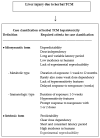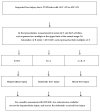Traditional Chinese Medicine (TCM) and Herbal Hepatotoxicity: RUCAM and the Role of Novel Diagnostic Biomarkers Such as MicroRNAs
- PMID: 28930128
- PMCID: PMC5456249
- DOI: 10.3390/medicines3030018
Traditional Chinese Medicine (TCM) and Herbal Hepatotoxicity: RUCAM and the Role of Novel Diagnostic Biomarkers Such as MicroRNAs
Abstract
Background: Traditional Chinese Medicine (TCM) with its focus on herbal use is popular and appreciated worldwide with increased tendency, although its therapeutic efficacy is poorly established for most herbal TCM products. Treatment was perceived as fairly safe but discussions emerged more recently as to whether herb induced liver injury (HILI) from herbal TCM is a major issue; Methods: To analyze clinical and case characteristics of HILI caused by herbal TCM, we undertook a selective literature search in the PubMed database with the search items Traditional Chinese Medicine, TCM, alone and combined with the terms herbal hepatotoxicity or herb induced liver injury; Results: HILI caused by herbal TCM is rare and similarly to drugs can be caused by an unpredictable idiosyncratic or a predictable intrinsic reaction. Clinical features of liver injury from herbal TCM products are variable, and specific diagnostic biomarkers such as microsomal epoxide hydrolase, pyrrole-protein adducts, metabolomics, and microRNAs are available for only a few TCM herbs. The diagnosis is ascertained if alternative causes are validly excluded and causality levels of probable or highly probable are achieved applying the liver specific RUCAM (Roussel Uclaf Causality Assessment Method) as the most commonly used diagnostic tool worldwide. Case evaluation may be confounded by inappropriate or lacking causality assessment, poor herbal product quality, insufficiently documented cases, and failing to exclude alternative causes such as infections by hepatotropic viruses including hepatitis E virus infections; Conclusion: Suspected cases of liver injury from herbal TCM represent major challenges that deserve special clinical and regulatory attention to improve the quality of case evaluations and ascertain patients' safety and benefit.
Keywords: HLA; RUCAM; Traditional Chinese Medicine; diagnostic biomarkers; herbal TCM hepatotoxicity; metabolomics; microRNA; microsomal epoxide hydrolase; pyrrole-protein adducts; pyrrolizidine alkaloids.
Conflict of interest statement
The authors declare no potential conflict of interests.
Figures




Similar articles
-
Herb-induced liver injury (HILI) with 12,068 worldwide cases published with causality assessments by Roussel Uclaf Causality Assessment Method (RUCAM): an overview.Transl Gastroenterol Hepatol. 2021 Jul 25;6:51. doi: 10.21037/tgh-20-149. eCollection 2021. Transl Gastroenterol Hepatol. 2021. PMID: 34423172 Free PMC article. Review.
-
Herbal Hepatotoxicity: Clinical Characteristics and Listing Compilation.Int J Mol Sci. 2016 Apr 27;17(5):588. doi: 10.3390/ijms17050588. Int J Mol Sci. 2016. PMID: 27128912 Free PMC article. Review.
-
Traditional Chinese Medicine and Herb-induced Liver Injury: Comparison with Drug-induced Liver Injury.J Clin Transl Hepatol. 2018 Mar 28;6(1):57-68. doi: 10.14218/JCTH.2017.00033. Epub 2017 Oct 27. J Clin Transl Hepatol. 2018. PMID: 29577033 Free PMC article. Review.
-
Herbal Traditional Chinese Medicine and suspected liver injury: A prospective study.World J Hepatol. 2017 Oct 18;9(29):1141-1157. doi: 10.4254/wjh.v9.i29.1141. World J Hepatol. 2017. PMID: 29085558 Free PMC article.
-
Causality assessment of herb-induced liver injury using multidisciplinary approach and Roussel Uclaf Causality Assessment Method (RUCAM).Clin Toxicol (Phila). 2011 Jan;49(1):34-9. doi: 10.3109/15563650.2010.537662. Epub 2010 Nov 29. Clin Toxicol (Phila). 2011. PMID: 21114414
Cited by
-
Idiosyncratic DILI: Analysis of 46,266 Cases Assessed for Causality by RUCAM and Published From 2014 to Early 2019.Front Pharmacol. 2019 Jul 23;10:730. doi: 10.3389/fphar.2019.00730. eCollection 2019. Front Pharmacol. 2019. PMID: 31396080 Free PMC article. Review.
-
Roussel Uclaf Causality Assessment Method for Drug-Induced Liver Injury: Present and Future.Front Pharmacol. 2019 Jul 29;10:853. doi: 10.3389/fphar.2019.00853. eCollection 2019. Front Pharmacol. 2019. PMID: 31417407 Free PMC article. Review.
-
A fermented mixed tea made with camellia (Camellia japonica) and third-crop green tea leaves prevents nonalcoholic steatohepatitis in Sprague-Dawley rats fed a high-fat and high-cholesterol diet.Hepatobiliary Surg Nutr. 2018 Jun;7(3):175-184. doi: 10.21037/hbsn.2017.08.03. Hepatobiliary Surg Nutr. 2018. PMID: 30046568 Free PMC article.
-
Approaches towards fighting the COVID‑19 pandemic (Review).Int J Mol Med. 2021 Jan;47(1):3-22. doi: 10.3892/ijmm.2020.4794. Epub 2020 Nov 20. Int J Mol Med. 2021. PMID: 33236131 Free PMC article. Review.
-
Herb-induced liver injury (HILI) with 12,068 worldwide cases published with causality assessments by Roussel Uclaf Causality Assessment Method (RUCAM): an overview.Transl Gastroenterol Hepatol. 2021 Jul 25;6:51. doi: 10.21037/tgh-20-149. eCollection 2021. Transl Gastroenterol Hepatol. 2021. PMID: 34423172 Free PMC article. Review.
References
-
- Wu W.Y., Yang W.Z., Hou J.J., Guo D.A. Current status and futures perspective in the globalization of Traditional Chinese Medicine. World J. Tradit. Chin. Med. 2015;1:1–4. doi: 10.15806/j.issn.2311-8571.2014.0027. - DOI
-
- Wang T. Development and expectation of modernization of herbal medicine. Zhongguo Zhong Xi Yi Jie He Za Zhi. 2013;33:1018–1029. (In Chinese) - PubMed
Publication types
LinkOut - more resources
Full Text Sources
Other Literature Sources
Molecular Biology Databases
Research Materials

